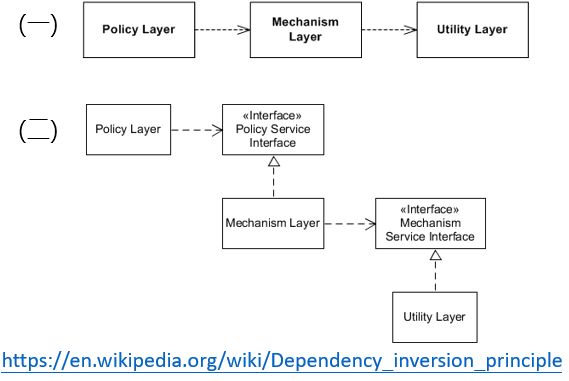敏捷開發
敏捷開發是一種用來應對快速變化的需求的開發方式,其強調軟體工程人員與業務人員面對面的溝通、頻繁交付可用的版本,使專案有彈性以因應不可預期的變化。常常聽到的 Scrum 與 Kanban 就是用來實現敏捷開發的框架。
敏捷開發最重要的四個方針:
- 個人與互動:重於流程與工具
- 可用的軟體:重於詳盡的文件
- 與客戶合作:重於合約協商
- 回應變化:重於遵循計劃
Single-Responsibility Principle (SRP) 單一職責原則
一個類別應只負責一個職責。
如果一個類別承擔過多職責 (高耦合),當需要修改或新增職責時,容易使得所有依賴此類別的地方都需要被修改,提高維護難度。透過分離職責來降低耦合,當需要新增、更改職責時,只需依照 interface 的定義來修改。
下方舉一個例子,首先定義一個訂單的資料結構,它可以透過影印機輸出。
1
2
3
4
5
6
7
8
9
10
public class Order
{
private string id;
private double price;
public void Print()
{
...
}
}
分析 Order 這個類別,它應該只專注處理地單的資訊,Print() 顯得超出它的職責了,假設今天有了新需求:透過 PDF 輸出,此時 Order 類別會變成:
1
2
3
4
5
6
7
8
9
10
11
12
13
14
15
public class Order
{
private string id;
private double price;
public void Print()
{
...
}
public void PrintByPdfExporter()
{
...
}
}
這時所有呼叫 Print 的地方都必須跟著改寫成相容於 PrintByPdfExporter 的邏輯,有許多處程式都必須修正。
現在套用 SRP 原則,定義一個 interface 叫 IPrinter,並讓 PdfExporter 和 Printer 實作 IPrinter:
1
2
3
4
5
6
7
8
9
10
11
12
13
14
15
16
17
18
19
20
21
22
23
24
25
26
27
28
29
30
31
32
33
34
35
36
37
38
public interface IPrinter
{
void Print(string id, double price);
}
public class PdfExporter : IPrinter
{
public void Print(string id, double price)
{
...
}
}
public class Printer : IPrinter
{
public void Print(string id, double price)
{
...
}
}
public class Order
{
private string id;
private double price;
private IPrinter printer;
public Order()
{
this.printer = new PdfExporter();
// this.Printer = new Printer();
}
public Print()
{
this.printer.Print(this.Id, this.Price);
}
}
如此一來,所有跟列印訂單有關的更改就限縮在個別的 IPrinter 實作中。
Open-Closed Principle (OCP) 開放封閉原則
對於擴展是開放的,對於修改是封閉的。
在下方範例中,DrawAllShapes 根據 ShapeType 來決定要畫出什麼圖案。每擴展一種形狀,就要修改一次 DrawAllShape 的 switch 區塊,增加了維護程式碼的複雜度。
1
2
3
4
5
6
7
8
9
10
11
12
13
14
15
16
17
18
19
20
enum ShapeType { Circle, Square };
struct Shape
{
ShapeType Type;
}
void DrawAllShapes(Shape* shapes, int n)
{
for (int i = 0; i < n; i++) {
switch(shapes[i].Type) {
case Square:
DrawSquare(shapes[i]);
break;
case Circle:
DrawCircle(shapes[i]);
break;
}
}
}
在下方範例,每擴展一種形狀,則完全不用更改 DrawAllShape,故符合 OCP 原則。
1
2
3
4
5
6
7
8
9
10
11
12
13
14
15
16
17
18
19
20
21
22
Interface Shape
{
void Draw();
}
public class Square : Shape
{
void Draw() { /* draw square here */ }
}
public class Circle : Shape
{
void Draw() { /* draw circle here */ }
}
void DrawAllShapes(Shape* shapes, int n)
{
for (int i = 0; i < n; i++)
{
shapes[i].Draw();
}
}
Liskov Substitution Principle (LSP) Liskov 替換原則
子類別應該完全符合父類別的特性。
在下方範例中,儘管邏輯上正方形可以被視為長方形的特例,但是在程式實作中,如果意外將正方形的物件視為長方形來使用,就有許多衍伸問題,例如正方形的 Width 和 Height 被誤設為不同的值。
1
2
3
4
5
6
7
8
9
10
11
12
13
14
15
16
17
18
19
20
21
22
23
24
25
26
27
28
29
30
31
32
33
34
35
36
public class Rectangle
{
protected int height;
protected int width;
public virtual int Height
{
get { return height; }
set { height = value; }
}
public virtual int Width
{
get { return width; }
set { width = value; }
}
public int Area
{
get { return width * height; }
}
}
public class Square : Rectangle {
public override int Height
{
get { return height; }
set { width = height = value; }
}
public override int Width
{
get { return width; }
set { width = height = value; }
}
}
套用上面的 Rectangle 與 Square,以下為一個違反 LSP 而造成 Bug 的案例:
1
2
3
4
5
6
7
8
9
10
11
12
13
14
15
16
17
// Program.cs
void stretch(Rectangle rect, int hValue, int vValue)
{
rect.Width += hValue;
rect.Height += vValue;
}
Rectangle rectangle = new Rectangle { Width = 5, Height = 5 };
Square square = new Square { Width = 5 };
Console.WriteLine(rectangle.Area);
Console.WriteLine(square.Area);
Console.WriteLine("---");
stretch(rectangle, 1, 1);
stretch(square, 1, 1);
Console.WriteLine(rectangle.Area);
Console.WriteLine(square.Area);
輸出為:
25
25
---
36
49
很明顯的 square 的長寬增加 1 後,面積應該要是 36,卻被誤算為 49。
Dependency-Inversion Principle (DIP) 依賴反向原則
1. 高層模組不應該直接依賴低層模組,它們都應該依賴抽象層。
2. 抽象層不應該因為低層模組而更改,反而低層模組要按照抽象層來實作。
下方程式碼中,高層的 Article 依賴低層的 ConsolePrinter。如此設計的缺點是,當低層模組變動時,會直接影響所有遞移性依賴的高層模組,使高層模組很可能也要跟著變動,比如 ConsolePrinter 增加了一些功能,並改名為 ColorPrinter 時,Article 中的 ConsolePrinter 也必須修正:
1
2
3
4
5
6
7
8
9
10
11
12
13
14
15
16
17
18
19
20
21
22
23
24
public class ConsolePrinter
{
public void Print(string text)
{
Console.WriteLine(text);
}
}
public class Article
{
private string text;
public ConsolePrinter printer;
public Article(string text)
{
this.text = text;
this.printer = new ConsolePrinter();
}
public void Print()
{
printer.Print(text);
}
}
下方程式碼中,Article 與 ConsolePrinter 都反過來依賴抽象介面 IPrinter,如此一來,只要 ConsolePrinter 按照 IPrinter 的介面來實作,就不會影響到 Article:
1
2
3
4
5
6
7
8
9
10
11
12
13
14
15
16
17
18
19
20
21
22
23
24
25
26
27
28
29
public interface IPrinter
{
void Print(string text);
}
public class ConsolePrinter
{
public void Print(string text)
{
Console.WriteLine(text);
}
}
public class Article
{
private string text;
public IPrinter printer;
public Article(string text)
{
this.text = text;
this.printer = new ConsolePrinter();
}
public void Print()
{
printer.Print(text);
}
}
舉另外一個例子:下圖一,高層的 Policy 依賴 Mechanism,Mechanism 依賴 Utility,因此 Policy 遞移性依賴 Utility。當低層模組變動時,會直接影響所有遞移性依賴的高層模組,使高層模組也有很大的可能需要要跟著修改。
下圖二則使用了 DIP 原則,所有模組都反過來依賴一個抽象介面,低層模組實作介面、高層模組透過介面使用低層模組。

Interface Segregation Principle (ISP) 介面隔離原則
不應強迫子類別去依賴它不使用的方法。
下左圖 IPets 的範例為了兼容 Dog 和 Cat 類別,所以定義了 bark() 方法,導致 Cat 類別必須也提供一個 bark() 的實作,導致了不必要的耦合。
下右圖把 IPetDogs 和 IPetCats 從 IPets 中隔離出來,讓 Dog 與 Cat 各自實作 bark() 和 meow(),這樣就讓貓狗可以用的方法區隔開來,避免不必要的實作與提升可讀性。
